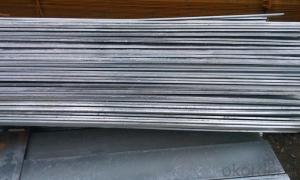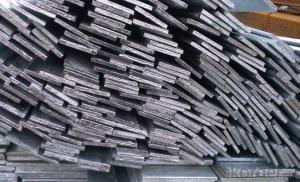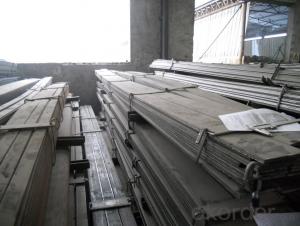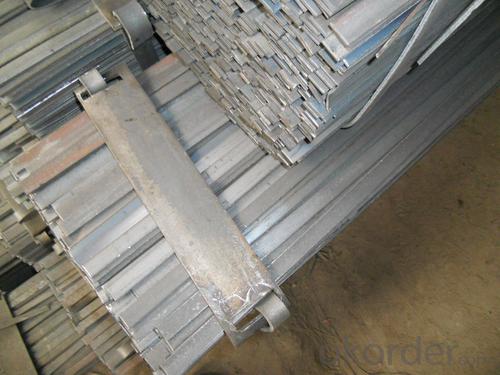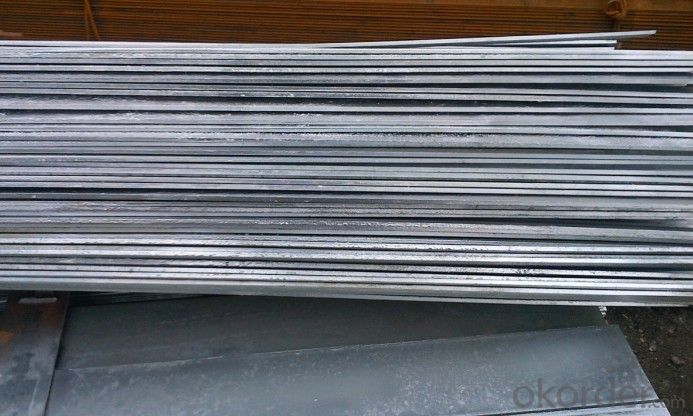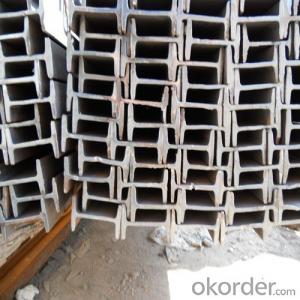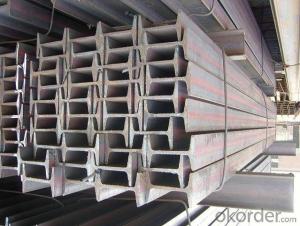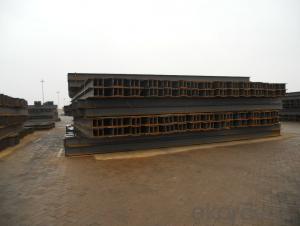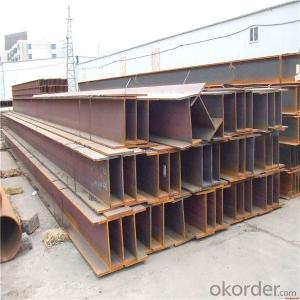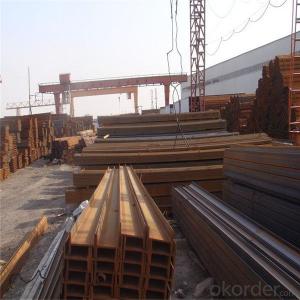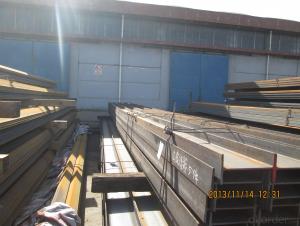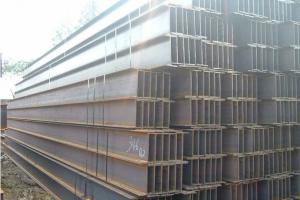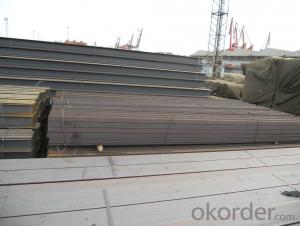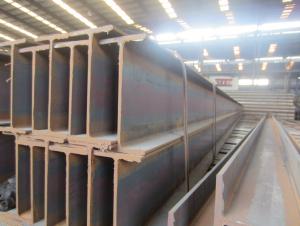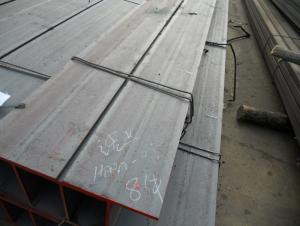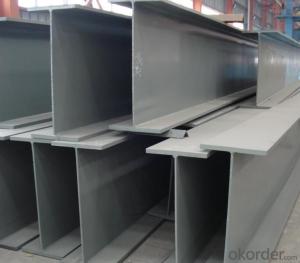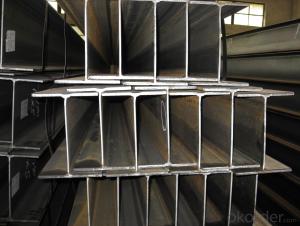H beam and gb
- Loading Port:
- China Main Port
- Payment Terms:
- TT OR LC
- Min Order Qty:
- -
- Supply Capability:
- -
OKorder Service Pledge
OKorder Financial Service
You Might Also Like
Product Description:
Product Description:
Specifications of Hot Rolled Structural Steel H Beam
1. Standard: GB700-88, Q235B2.
2. Grade: Q235, SS400 or Equivalent
3. Length: 6m,10m, 12m as following table
4. Invoicing on theoretical weight or actual weight as customer request
5.Payment: TT or L/C
6. Sizes:
SIZE(mm) | DIMENSION(kg/m) |
100*100 | 16.9 |
125*125 | 23.6 |
150*75 | 14 |
150*150 | 31.1 |
148*100 | 20.7 |
198*99 | 17.8 |
200*100 | 20.9 |
248*124 | 25.1 |
250*125 | 29 |
Usage & Applications of Hot Rolled Structural Steel H Beam
Commercial building structure ;Pre-engineered buildings; Machinery support structure; Prefabricated structure; Medium scale bridges; Ship-building structure. etc.
Packaging & Delivery of Hot Rolled Structural Steel H Beam
1. Packing: it is nude packed in bundles by steel wire rod
2. Bundle weight: not more than 3.5MT for bulk vessel; less than 3 MT for container load
3. Marks:
Color marking: There will be color marking on both end of the bundle for the cargo delivered by bulk vessel. That makes it easily to distinguish at the destination port.
Tag mark: there will be tag mark tied up on the bundles. The information usually including supplier logo and name, product name, made in China, shipping marks and other information request by the customer.
If loading by container the marking is not needed, but we will prepare it as customer request.
4. Transportation: the goods are delivered by truck from mill to loading port, the maximum quantity can be loaded is around 40MTs by each truck. If the order quantity cannot reach the full truck loaded, the transportation cost per ton will be little higher than full load.
5. Delivered by container or bulk vessel
- Q: Are steel H-beams suitable for use in high-rise buildings?
- Indeed, steel H-beams prove to be a suitable option for utilization in high-rise constructions. Their reputation for strength and durability renders them an optimal selection for sustaining substantial loads in towering edifices. These beams possess an impressive capacity to bear weight and endure the forces and stresses exerted by the accumulation of multiple floors and the wind loads characteristic of elevated structures. Moreover, their structural shape provides exceptional support and stability, facilitating the efficient distribution of the building's weight. Furthermore, steel H-beams boast easy fabrication and are available in an assortment of sizes and lengths, lending them versatility and adaptability to various high-rise building designs. Consequently, steel H-beams stand as a dependable and extensively employed preference for establishing the structural framework of high-rise buildings.
- Q: Can steel H-beams be recycled?
- Indeed, steel H-beams can be recycled. Steel, being one of the most recycled materials globally, applies to H-beams made of this material as well. The act of recycling steel H-beams not only aids in lessening the environmental impact associated with mining and manufacturing new steel but also helps conserve energy and resources. The recycling procedure typically involves the collection of H-beams, their subsequent sorting based on their steel grade, and their eventual melting down in a furnace. The resulting molten steel is then utilized in the creation of fresh steel products, which may encompass H-beams or other structural components. By engaging in the recycling of steel H-beams, we can actively contribute to the promotion of a more sustainable and circular economy.
- Q: What are the design considerations for steel H-beam structures?
- Steel H-beam structures must take into account several design considerations: 1. Load-bearing capacity: The primary focus of structural design is to ensure that the H-beam structure can support the intended loads. This involves calculating the maximum expected loads, such as the weight of the structure itself, occupant loads, equipment loads, wind loads, snow loads, and seismic forces. The H-beam must be able to withstand these forces without failing or deflecting excessively. 2. Material selection: Selecting the appropriate steel grade is crucial for maintaining structural integrity. Different steel grades have different properties in terms of strength, toughness, and corrosion resistance. The choice should be based on the specific requirements of the project, including expected loads, environmental conditions, and budget constraints. 3. Beam size and shape: Determining the optimal size and shape of the H-beam is crucial for achieving the desired structural performance. Factors such as span length, column spacing, and floor-to-floor height affect the selection of beam sizes. Structural engineers perform extensive calculations to find the most efficient and cost-effective dimensions that meet the design criteria. 4. Connection design: The connections between H-beams and other structural elements, such as columns or beams, must be meticulously designed to ensure load transfer and overall stability. The connection design should consider factors such as load distribution, ease of construction, and maintenance requirements. Common connection methods include welding, bolting, and riveting. 5. Fire protection: Steel is susceptible to heat, so fire protection is a critical design consideration for H-beam structures. Fire-resistant coatings or insulating materials are often applied to the steel members to delay or prevent structural failure during a fire. These fire protection measures must comply with local building codes and fire safety regulations. 6. Architectural integration: In addition to structural considerations, H-beam designs often need to align with architectural requirements. Architects and structural engineers collaborate to seamlessly integrate the H-beam structure into the overall aesthetic and functional design of the building. This may involve concealing or incorporating the beams into architectural elements such as ceilings, walls, or facades. 7. Sustainability and cost-effectiveness: Designing steel H-beam structures with sustainability and cost-effectiveness in mind is crucial. This includes optimizing material usage to minimize waste, considering long-term maintenance and durability, and selecting energy-efficient design solutions. Additionally, the design should aim to minimize the overall cost of the structure while meeting the required performance criteria. In conclusion, careful consideration of these design factors ensures that steel H-beam structures are safe, durable, and efficient for their intended purposes.
- Q: Can steel H-beams be used in educational institution construction?
- Certainly, educational institution construction can incorporate steel H-beams. The utilization of steel H-beams is widespread in the construction industry owing to their exceptional strength, durability, and adaptability. They offer structural stability and support across diverse building applications, including educational institutions. H-beams are instrumental in constructing the framework of the building, encompassing columns, beams, as well as providing floor support and roof structures. Moreover, steel H-beams are capable of withstanding substantial loads and boast an extended lifespan, rendering them a fitting choice for robust construction in educational buildings.
- Q: How do steel H-beams contribute to sustainable design?
- Steel H-beams contribute to sustainable design by providing structural strength and durability, allowing for the construction of long-lasting and resilient buildings. Their high load-bearing capacity enables the use of fewer materials, reducing resource consumption and minimizing waste. Moreover, steel H-beams are often made from recycled materials, reducing the demand for new raw materials and lowering carbon emissions. Additionally, their versatility and ease of installation make them suitable for various building types and designs, promoting flexibility and adaptability in sustainable construction practices.
- Q: How do steel H-beams perform in areas with high wind speeds?
- Steel H-beams perform exceptionally well in areas with high wind speeds. The structural design and strength of H-beams make them highly resistant to wind forces. Their robust construction ensures stability and minimizes the risk of structural failure, even in extreme weather conditions. Overall, H-beams are a reliable choice for withstanding high wind speeds.
- Q: What are the different types of steel H-beam connections used in high-rise buildings?
- There are several types of steel H-beam connections commonly used in high-rise buildings. These include bolted connections, welded connections, and hybrid connections. Bolted connections involve using bolts and nuts to connect the H-beams together. Welded connections, on the other hand, involve welding the H-beams together to create a strong and rigid connection. Hybrid connections combine both bolted and welded connections, utilizing the advantages of both methods. The choice of connection type depends on factors such as structural requirements, load-bearing capacity, and construction feasibility.
- Q: What are the different applications of steel H-beams?
- Steel H-beams have a wide range of applications in various industries due to their structural strength and versatility. Some of the different applications of steel H-beams include: 1. Construction: Steel H-beams are commonly used in the construction industry for structural support in buildings, bridges, and other infrastructure projects. They provide excellent load-bearing capabilities, making them ideal for supporting heavy loads and spanning long distances. 2. Industrial Manufacturing: Steel H-beams are also used in the manufacturing sector for constructing frames and supports for heavy machinery and equipment. Their strong structural properties allow them to withstand the weight and vibrations generated by industrial processes. 3. Automotive Industry: Steel H-beams are utilized in the automotive industry for manufacturing chassis frames and structural components of vehicles. The high strength and durability of steel make it an ideal material for ensuring the safety and stability of automobiles. 4. Shipbuilding: Steel H-beams find extensive use in shipbuilding due to their ability to withstand harsh marine environments and support the weight of large vessels. They are commonly employed in the construction of ship hulls, decks, and structural components. 5. Aerospace Industry: Steel H-beams are employed in the aerospace industry for various applications, including aircraft frames, fuselage structures, and landing gear supports. The high strength-to-weight ratio of steel makes it a suitable material for ensuring the structural integrity of aircraft. 6. Railway Infrastructure: Steel H-beams are widely used in the railway industry for constructing railway bridges, platforms, and tracks. Their robustness and load-bearing capacity make them suitable for withstanding heavy train traffic and maintaining stability. 7. Mezzanine Floors: Steel H-beams are commonly utilized in the construction of mezzanine floors, which provide additional storage space or work areas in commercial buildings. The beams support the weight of the floor and any loads placed on it. 8. Transmission Towers: Steel H-beams are employed in the construction of transmission towers used for power lines and telecommunication networks. The beams provide the necessary structural strength to support the weight of the cables and withstand external forces such as wind and seismic loads. Overall, steel H-beams have diverse applications across several industries due to their structural strength, durability, and versatility. Their ability to support heavy loads and span long distances makes them an ideal choice for various construction, manufacturing, transportation, and infrastructure projects.
- Q: Can steel H-beams be used for railway stations?
- Yes, steel H-beams can be used for railway stations. Steel H-beams are commonly used in the construction industry due to their strength and durability. They are capable of supporting heavy loads, making them suitable for railway station structures, which need to bear the weight of trains and various equipment. Steel H-beams can be used for railway station platforms, overhead walkways, supporting structures for roofs, and other critical components. Additionally, steel is a versatile material that can be easily fabricated and customized to meet the specific design requirements of railway stations.
- Q: What is the fire rating of steel H-beams?
- The fire rating of steel H-beams typically depends on various factors such as the size and thickness of the beam, the type and thickness of any fire-resistant coatings or treatments applied to the beam, and the overall fire protection system in place. Generally, steel is considered to have inherent fire-resistant properties compared to other building materials such as wood. However, without additional fire protection measures, steel H-beams can lose their load-bearing capacity in high temperatures due to thermal expansion and structural deformation. To improve the fire resistance of steel H-beams, fire protection measures can be implemented, including fire-resistant coatings or fireproofing materials that are applied to the surface of the beams. These coatings or materials are designed to provide a certain level of fire resistance by retarding the heat transfer and delaying the point at which the steel reaches its critical temperature. The fire rating assigned to steel H-beams will depend on the specific fire protection measures employed. Fire ratings are typically expressed in terms of time, such as 30 minutes, 60 minutes, 90 minutes, or 120 minutes, indicating the duration for which the steel beams can withstand fire exposure without significant loss of structural integrity or load-bearing capacity. It is essential to consult with fire protection engineers, architects, and relevant building codes or standards to determine the appropriate fire rating for steel H-beams in a specific application.
Send your message to us
H beam and gb
- Loading Port:
- China Main Port
- Payment Terms:
- TT OR LC
- Min Order Qty:
- -
- Supply Capability:
- -
OKorder Service Pledge
OKorder Financial Service
Similar products
Hot products
Hot Searches
Related keywords

